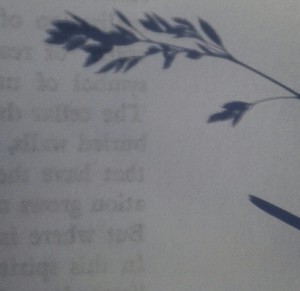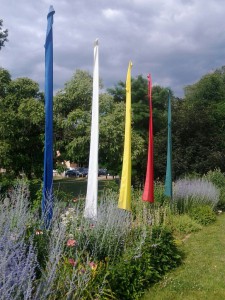Wednesday
Arts and PoetryBreath’s Sibling
 On Contemplative Being
On Contemplative Being
by Ginger Teppner, Naropa University
Contemplative writing (breath’s sibling) creates a portal that connects interior to exterior. The term contemplation inhabits this space of attention. It requires focus and deliberate release. The release of the known. It is not enough to explore the interiority of self alone.
Spiral inward. Follow a line of text to its source. Inhale, but understand exhalation is mandatory. Juliana Sparh writes: “In this everything turning and small being breathed in and out by everyone with lungs during all the moments … How connected we are with everyone”. In this manner the more we breathe, contemplate the depths through words, and connect to everything on the inside of outside, the more we realize there is inevitably no in or out, no us and other, only thread strands tied together to form a soul line deeper than blood line that spans landscape of cell, body, language, culture, earth, space, and time.
We are gathered here in soft space and shoddy space, especially in the in-between space. This is why we went to the caves to write out our existence. The cave is an in-between space, a permeable surface space, a touchable metaphor space of our most alive-ness because within this surface is the circuitry to connect depth of interior to depth of exterior. Our folly is forgetfulness, how we are prone to forget our intrinsic full-ness, the fullness of space within and without, the full-ness of alive-ness even as we explode into the minutest particle, expand as ocean rift, attempt to destroy or birth our self.
To contemplate then is to live the cell. To live the body, the earth, the space. To live the time. A translation of the experience of I, which is poem, which is world, which is body.
A translation as attempt to get closer to authentic, to get closer to non-representation, to get closer to creation or source.
A translation in emptiness space of no separation between observer and observed.
A hall of mirrors, a circle within a circle, a line of text, sinew.
To write this emptiness space where unattainable desires and already attained aspirations co-exist, much like two fingertips that appear to touch, do in fact touch, but are never really touching because the empty space between them can always be divided into smaller and smaller space, which conversely contains emptiness space in its indelible entirety, is to contemplate emptiness space entered through the breath, breath that is synonymous with empty (blank) space, a circular territory that resists mapping, as we resist the inherent disastablishing-ness of living.To write contemplatively is to equate the physical body with a textual body, to equate the textual body with texture. For example: there is a specific texture to the experience of rejection. It vibrates at a mirrored frequency no different from that of a suffering embargoed nation. It is a texture of resist. There is a specific texture to the death of a child. It vibrates at a mirrored frequency no different from a river that no longer flows. It is a texture of lack.
The texture of acceptance absorbs green.
The texture of love swallows fresh.
The texture of connection breathes seismic.
The texture of desire relishes thorny.
Contemplation absorbs, swallows, breathes, and relishes in order to relinquish a consciousness attentive to resistance and lack.
Contemplative writing; therefore, is a bridge to the surface of the moon and the ocean floor, both which become as close as my liver or your neurons, depending on intention.
Contemplative writing is a letting go of, a going to away from, a being on the go to.
To be. To go. To being going. Contemplative being.
In this way we are contemplating verbs: we are becoming by securing our own loose threads and by leaving the window of possibility open. We are becoming by standing within ourselves while we inhabit the potentiality to stand luminous within each other.
Contemplative writing is a healing balm. To heal is to restore to wholeness. Health is to be free from abnormality, therefore; contemplation is a personal responsibility to be healthy, but this responsibility looks more like tending our own (individual, which cannot be unhinged from the collective) garden. Tending involves paying close attention to the inseparable inside and outside, to the permeable membrane between also named telling. Anne Carson writes: “To tell is a function of self — a dream of distance in which the self is displaced from the center of the work and the teller disappears into the telling.”
The contemplative teller tells and through the telling becomes part of the told, and the dream of distance between teller (interior depth), telling (surface, both textual and physical), and told (exterior depth) resembles what it is: an illusion of separation.
Thus, contemplative writing (breath’s sibling) creates a portal that connects the inside with the outside. We witness the illusion of separation.
 ~~
~~
Ginger Teppner is a wolfish poet mother inhabiting the body of a bartender that works at a country club in the central-most county in the state of Florida, otherwise referred to as the sunshine state or the lightning capitol of the world, depending on perspective. She is a Creative Writing MFA Candidate at Naropa University.






Sep 2, 2013
Reply
Thank you for this lovely description of inner-outer writing. I have been practicing this for many years and it connects deeply with me. Your signature description inspires me to be more articulate in my own!
Aug 28, 2013
Reply
Gorgeous .